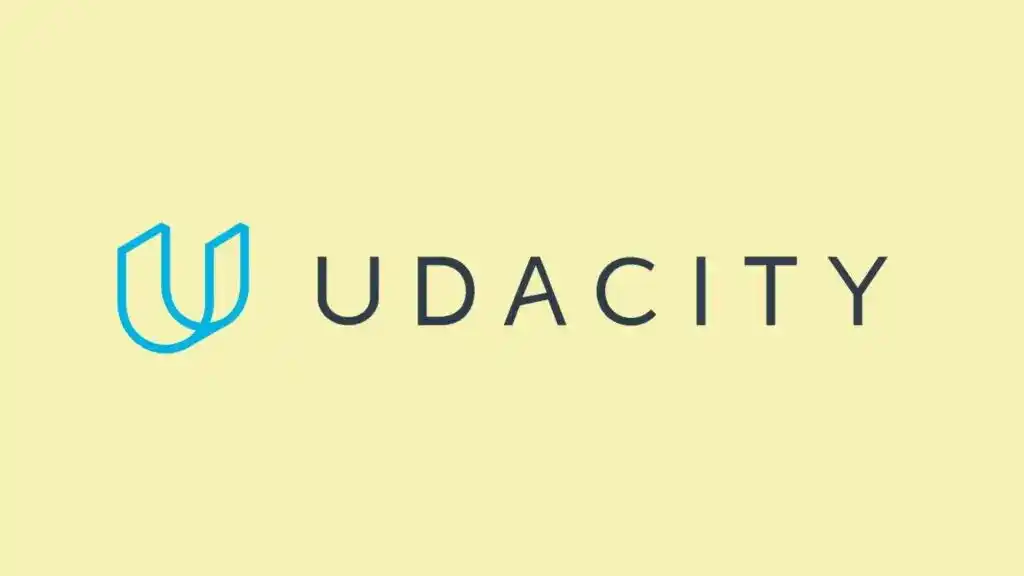Are you planning to enroll in Udacity Data Engineering Nanodegree? If yes, read this latest Udacity Data Engineering Nanodegree Review and its Pros and Cons. This Udacity Data Engineering Nanodegree review will help you to decide whether this Nanodegree program is good for you or not.
So, without further ado, let’s get started-
- My Personal Experience with Udacity Data Engineering Nanodegree
- Pros and Cons of Udacity Data Engineering Nanodegree
- How are the Content & Projects of Udacity Data Engineering Nanodegree?
- Should You Enroll in Udacity Data Engineer Nanodegree?
- How Much Time and Money Do You Have to Spend on Udacity Data Engineering Nanodegree?
- How to Complete the Udacity Data Engineering Nanodegree In Less Time?
- How to Get Udacity Scholarship?
- Are Instructors Experienced?
- Pros of Udacity Data Engineering Nanodegree
- Cons of Udacity Data Engineering Nanodegree
- Is Udacity Data Engineer Nanodegree Worth It?
- Final Thought
- FAQ
Udacity Data Engineering Nanodegree Review
Before we dive into a Udacity Data Engineering Nanodegree Review, I would like to clear one thing-
Udacity Data Engineering Nanodegree is not a beginner-level program. This is an intermediate-advanced data engineering course. So, If you don’t have previous Python and SQL knowledge, don’t directly enroll in this program.
In this case, you can check Programming for Data Science with Python.
Now, I would like to share my personal experience with Udacity Data Engineering Nanodegree in a brief way-
My Personal Experience with Udacity Data Engineering Nanodegree
| Category | Rating (Out of 5) | Review |
|---|---|---|
| Course Content | 4.5 | I found the course content to be excellent. It covered a wide range of data engineering topics and was well-structured, making it easy to follow. |
| Practical Exercises | 4.0 | The practical exercises were really helpful. They allowed me to apply what I learned and gain hands-on experience, which solidified my understanding. |
| Projects | 4.5 | The projects were challenging but rewarding. They gave me the opportunity to showcase my skills and apply data engineering concepts to real-world scenarios. |
| Support and Feedback | 4.0 | The support and feedback from the Udacity team were great. They were responsive to my questions and provided valuable guidance throughout the program. |
| Job Assistance | 3.5 | The job assistance offered some helpful resources and advice. However, I felt that more personalized support could have been provided to assist with my specific job search. |
| Community | 3.5 | The community aspect was decent. I was able to connect with other students, but I would have liked to see more engagement and collaboration among participants. |
| Overall Experience | 4.0 | Overall, my experience with the Udacity Data Engineering Nanodegree was positive. The content, exercises, and projects were valuable, and the support was great. However, I believe there is room for improvement in the job assistance and community engagement aspects. |
Now, let’s see the Pros and Cons of the Udacity Data Engineering Nanodegree-
Pros and Cons of Udacity Data Engineering Nanodegree
Pros-
- Provides hands-on labs to practice throughout each lesson.
- Covers the industry best practice to write code, documentation, and real-time projects.
- Provides a better knowledge about OLAP vs. OLTP, normalization, denormalization, and how to implement it into practice.
- The projects not only assess your knowledge of the subject being covered but continually enforce good programming practices.
- The content is well-developed and intuitive.
- Provides a good explanation of SQL vs. NoSQL.
- Discuss Postgres and Apache Cassandra commands.
- Provides perfect exposure to skills required in the data engineering industry.
- Focus on hands-on practice and believe in “how” to do things like ETL and Data Warehousing.
- Good explanation of distributed file systems and cluster computing.
- Clears the doubt between PySpark data frames and PySpark SQL.
- Provides Technical mentor support.
- Great community to help.
Cons-
- Expensive
- Some of the lectures are not very polished.
- Data Modeling exercises have bugs.
- The demonstration code sample is not available to students.
- A bit of revision of Python and SQL is required.
- After completing the Nanodegree program, you will not get lifetime access to the course material.
So these are the Pros and Cons of the Udacity Data Engineering Nanodegree. Now let’s see how is the content of Udacity Data Engineering Nanodegree and what projects are covered throughout the Nanodegree program.
How are the Content & Projects of Udacity Data Engineering Nanodegree?
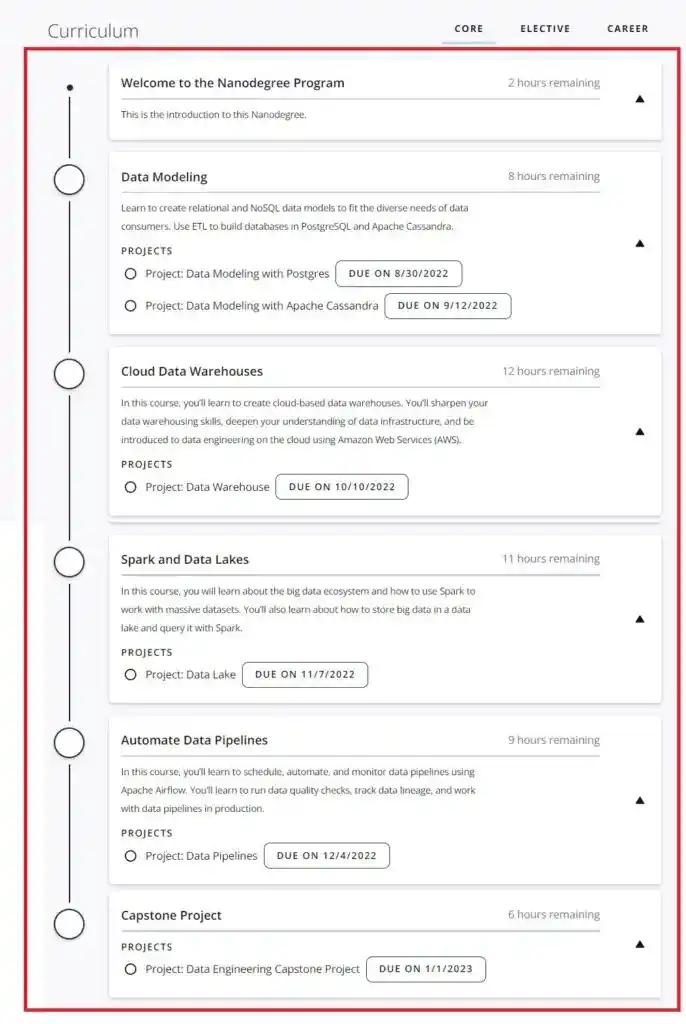
The Udacity data engineering Nanodegree has 5 courses and 6 projects. Each course has 3-4 lessons and 1-2 Course Projects. You need to submit these guided projects after completing the course. And the contractor hired by Udacity reviews your projects.
Due to its practical approach, you will get to learn various new things. Because when you implement it by yourself, your understanding becomes stronger.
These are the 5 courses in Udacity Data Engineering Nanodegree–
Course 1. Data Modeling
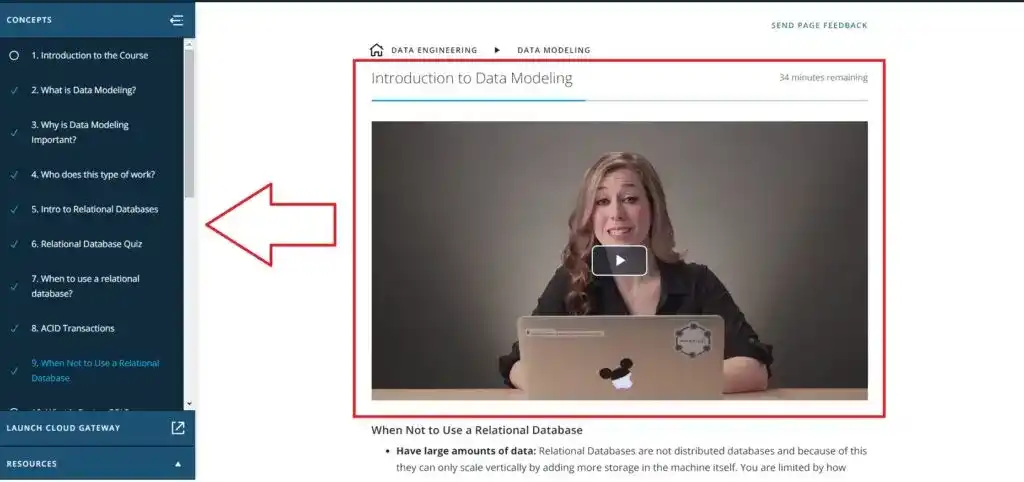
This is the first course where you will learn how to create NoSQL and relational data models to fill the needs of data consumers. You will also learn how to choose the appropriate data model for a given situation. Each course has some lessons. There are three lessons in the first course.
In the first lesson, you will learn the fundamentals of data modeling and how to create a table in Postgres and Apache Cassandra.
In the second lesson, concepts of normalization and denormalization will be introduced with hands-on projects. And you will also know the difference between OLAP and OLTP databases.
The third lesson of this course will teach you when to use NoSQL databases and how they differ from relational databases. You will also learn how to create a NoSQL database in Apache Cassandra.
Check the current Discount on-> Udacity Data Engineering Nanodegree
Project Details
There are two projects in this first-course Data Modeling with Postgres and Data Modeling with Apache Cassandra.
In these projects, you have to model user activity data for a music streaming app called Sparkify. For this, you have to create a database and ETL pipeline, in both Postgres and Apache Cassandra, designed to optimize queries for understanding what songs users are listening to.
Course 2. Cloud Data Warehouses
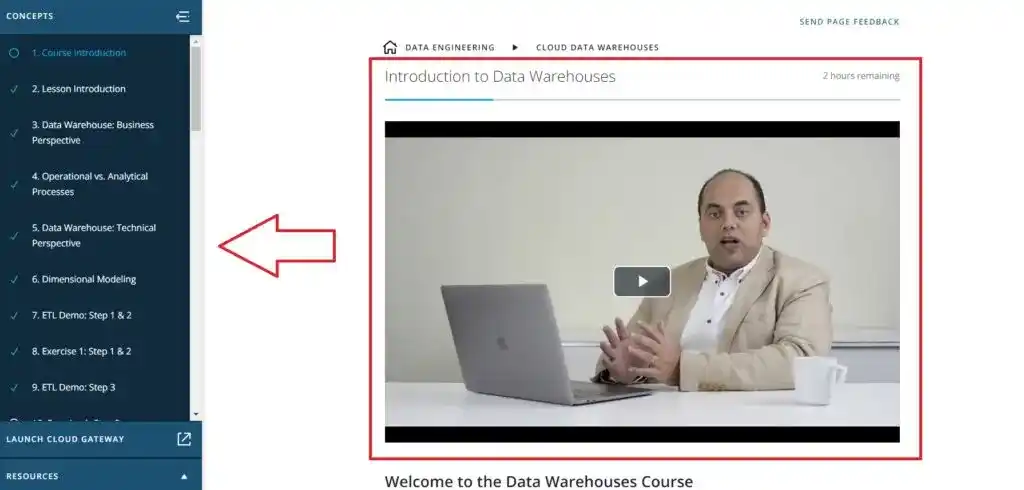
The second lesson is focused on data warehousing, specifically on AWS. You will also learn various techniques like Kimball, Inmon, Hybrid, OLAP vs OLTP, Data Marts, etc. Some of the AWS tools that you’ll be using here are IAM, S3, EC2, and RDS instances.
There are three lessons in this course. In the first lesson, you will understand Data Warehousing architecture, how to run an ETL process to denormalize a database (3NF to Star), how to create an OLAP cube from facts and dimensions, etc.
The second lesson will help you to understand cloud computing and teach you how to create an AWS account and understand their services, and how to set up Amazon S3, IAM, VPC, EC2, and RDS PostgreSQL.
In the third lesson, you will learn how to implement Data Warehouses on AWS. You will also learn how to identify components of the Redshift architecture, how to run the ETL process to extract data from S3 into Redshift, and how to set up AWS infrastructure using Infrastructure as Code (IaC).
Project Details
In this course, there is one project where you have to build a cloud data warehouse to find insights into what songs their users are listening to. And for this, you have to build an ELT pipeline that extracts their data from S3, stages them in Redshift, and transforms data into a set of dimensional tables.
Course 3. Spark and Data Lakes
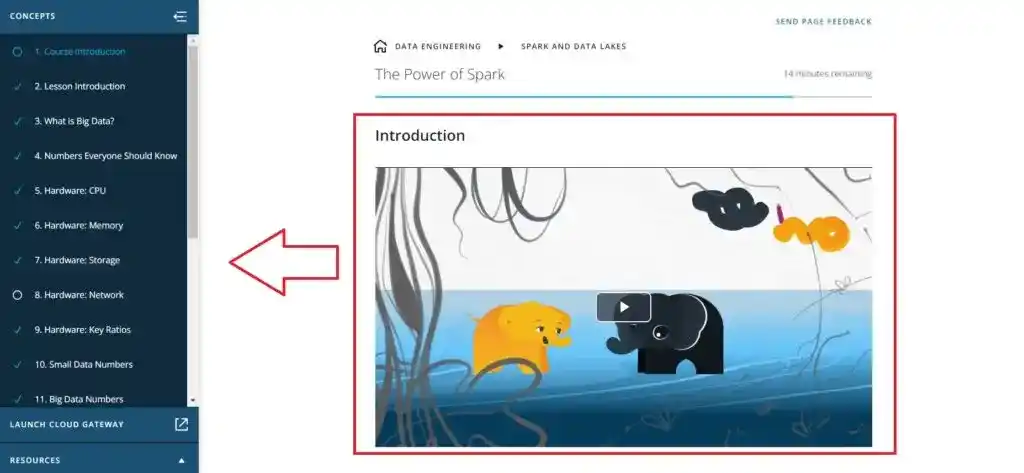
This course provides an introduction to Apache Spark and Data Lakes. In this course, you will learn how to use Spark to work with massive datasets and how to store big data in a data lake and query it with Spark. You will also learn concepts such as distributed processing, storage, schema flexibility, and different file formats.
There are four lessons. In the first lesson, you will learn more about Spark and understand when to use Spark and when not to use it.
The second course will teach you data wrangling with Spark and how to use Spark for ETL purposes. In the third course, you will learn about debugging and optimization and how to troubleshoot common errors and optimize their code using the Spark WebUI.
The fourth course is all about data lakes and teaches you how to implement data lakes on Amazon S3, EMR, Athena, and Amazon Glue. You will also understand the components and issues of data lakes.
Project Details-
In this course, there is one project where you have to create an ETL pipeline for a data lake, using data stored in AWS S3 in JSON format. And for this, you have to load data from S3, process the data into analytics tables using Spark, and load them back into S3.
Course 4. Automate Data Pipelines
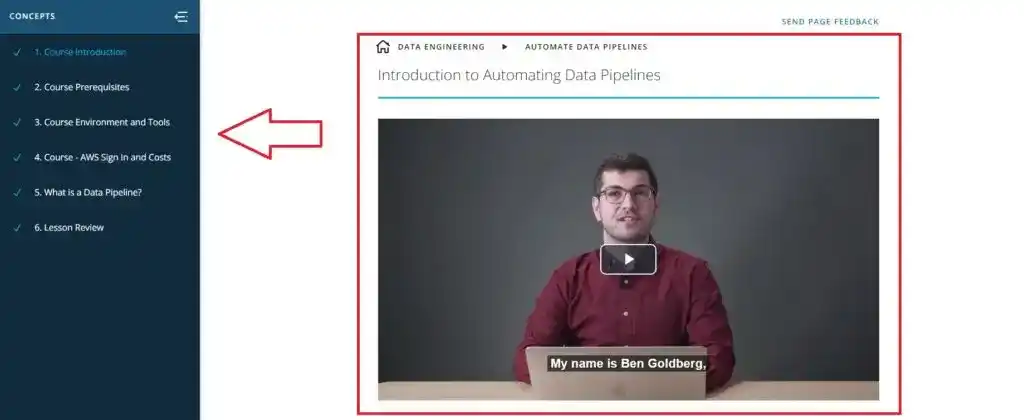
In the fourth course, you’ll use all the technologies learned in the above 3 courses. This is an exciting course where you will get an introduction to Apache Airflow and how to schedule, automate, and monitor data pipelines using Apache Airflow.
There are three lessons in this course. In the first lesson, you will learn how to create data pipelines with Apache Airflow, how to set up task dependencies, and how to create data connections using hooks.
In the second lesson, you will learn about data quality such as partitioning data to optimize pipelines, writing tests to ensure data quality, tracking data lineage, etc.
Project Details
There is one project in this course, where you have to build data pipelines with Airflow. In this project, you will work on the music streaming company’s data infrastructure by creating and automating a set of data pipelines. You have to configure and schedule data pipelines with Airflow and monitor and debug production pipelines.
5. Udacity Data Engineering Capstone Project
The last course is a capstone project. Where you will combine all the technologies learned in the entire course and build a data engineering portfolio project.
In this Udacity Data Engineering Capstone Project, you have to gather data from several different data sources, transform, combine, and summarize it, and create a clean database for others to analyze. Throughout the project guidelines, suggestions, tips, and resources will be provided by Udacity.
Now, let’s see whether you should enroll in the Udacity Data Engineer Nanodegree program or not-
Should You Enroll in Udacity Data Engineer Nanodegree?
Udacity Data Engineering Nanodegree is not a beginner-level program. This is the only intermediate-advanced data engineering course out there. This Nanodegree program requires the following skills before enrolling in the program-
Python–
If you are a beginner in Python, then don’t directly enroll in this program. To get 100% from Udacity Data Engineering Nanodegree Program, you need to know the following concepts-
- Strings, numbers, and variables; statements, operators, and expressions;
- Lists, tuples, and dictionaries; Conditions, loops;
- Procedures, objects, modules, and libraries;
- Troubleshooting and debugging; Research & documentation;
- Problem-solving; Algorithms and data structures
2. SQL-
Along with Python knowledge, you should be familiar with SQL programs such as Joins, Aggregations, Subqueries, Table definition, and manipulation (Create, Update, Insert, Alter).
If you meet the following prerequisites, then you can enroll in the Udacity Data Engineering Nanodegree. If not, first learn Python and SQL.
Now let’s see the price and duration of the Udacity Data Engineering Nanodegree program-
How Much Time and Money Do You Have to Spend on Udacity Data Engineering Nanodegree?
According to Udacity, the Udacity Data Engineering Nanodegree program will take 5 months to complete if you spend 5-10 hours per week.
And for 5 months they cost more than $800. But Udacity offers two options- One is either pay the complete amount upfront or you can pay monthly installments of $399/month.
So this is according to Udacity, but here I would like to tell you how you can complete the full Udacity Data Engineering Nanodegree program in less time.
Excited to know…How?
So, let’s see-
How to Complete the Udacity Data Engineering Nanodegree In Less Time?
To complete the Udacity Data Engineering Nanodegree program in less time, you need to manage your time productively.
You need to plan your day before and create a to-do list for each day. And you need to spend a good amount of time daily on the program.
According to Udacity, you need to spend 10 hours per week to complete the whole program in 5 months.
Right…?
That means, daily you need to spend 1.5 hours, but if you double the time and give daily 3 hours, then you can complete the whole Nanodegree program in less than 3 months.
For managing your time and avoiding any distractions, you can use the Pomodoro technique to increase your learning.
As I mentioned earlier, after each course, you have to work on a project. And each project has a set of rubrics. So before starting a section, I would suggest you just study the rubrics of the project. The rubrics will provide you with a rough idea about what topics and lectures are important for the project. So that you can make notes while watching these lectures.
And you can also implement the project phases after watching the related lecture. By doing this way, you can save time by watching one video two times. One at the time of learning and the second at the time of working on the project.
I hope these tips will help you to complete the Udacity Data Engineering Nanodegree program in less time. But you can also get Udacity Scholarship.
Do you want to know…How?
So, let me tell you how to get Udacity Scholarship.
How to Get Udacity Scholarship?
To apply for Udacity Scholarship, you need to go to their Scholarship page, which looks like that-
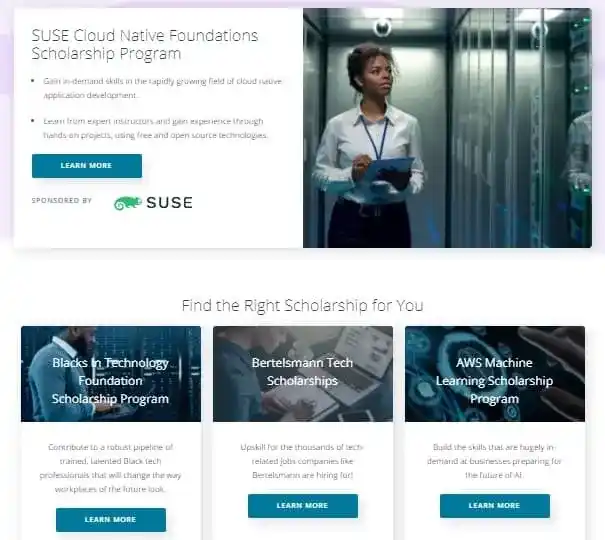
On this page, you have to find the scholarship for the program you want to enroll. If you found your Nanodegree program on the list, then you need to apply for the scholarship by filling out these details-
- Background Information
- Prerequisite Knowledge
- Your Goals
- Additional Questions
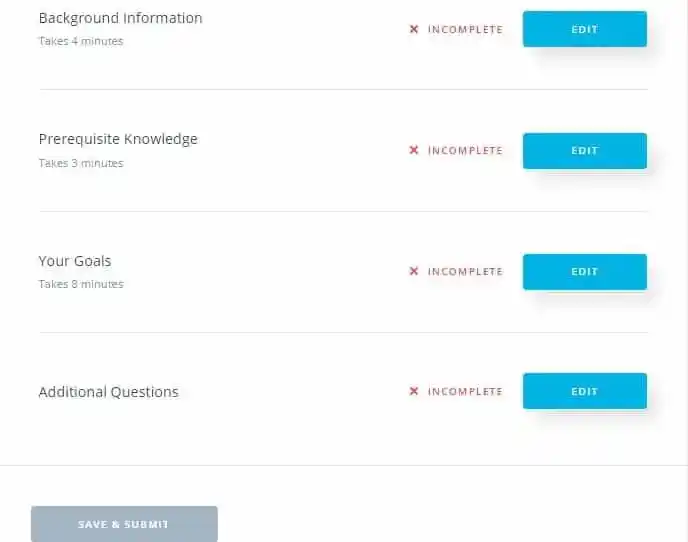
After filling out these details, you need to click on the “Save and Submit“ button. And by doing so, you have applied for Udacity Scholarship. And if you are selected, then you will be notified via email.
But if your program is not listed in the scholarship section, then you fill out this form on the Scholarship page section-
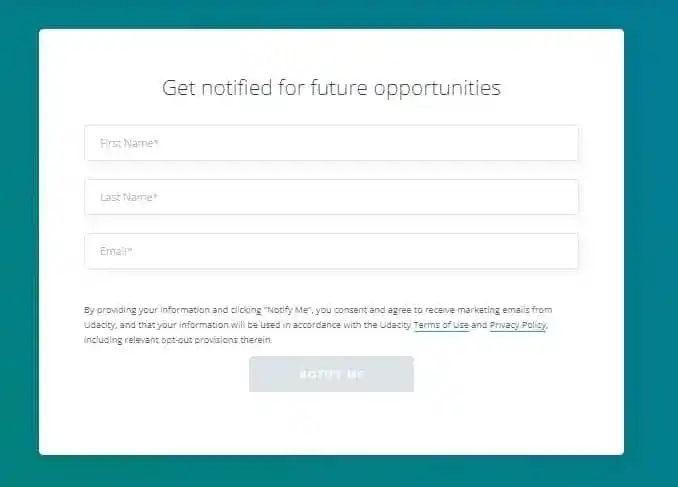
So, when there will be a new scholarship available, you will be notified. I hope now you understood how to apply for a Udacity scholarship.
The next important thing you need to know is who will teach you and what their qualifications are. So, let’s see the information of the Instructors-
Are Instructors Experienced?
- Amanda Moran– She is a developer advocate at DATASTAX.
- Ben Goldberg– Staff Engineer at SPOTHERO
- Sameh El-Ansary– CEO of Novelari & Assistant professor at Nile University
- Olli Livonen– Data Engineer at WOLT
- David Drummond- VP of Engineering at Insight
- Judit Lantos- Data Engineer at Split
- Juno Lee- Instructor
Learning from such experienced and knowledgeable instructors is amazing and helpful. This is the reason, I personally love Udacity. Udacity also has its forums, where you can ask your doubt to instructors, and they will answer your query.
Now I would like to mention some more Pros and Cons of the Udacity Data Engineering Nanodegree.
Pros of Udacity Data Engineering Nanodegree
- The structure of the course is perfect if you are focused on hands-on practice and believe in “how” to do things like ETL and Data Warehousing.
- You will get Technical mentor support and the mentor will guide you from the start of your Nanodegree program until you finish the whole program.
- Provides good background information on data modeling, and traditional data schemas.
- The Udacity Data Engineering Nanodegree highlights data quality and data governance and how to introduce tests within your data pipeline.
- Udacity provides a great community of help. They have a Stackoverflow-style Q&A forum for people who are stuck with assignments, but it also has a pretty large slack, with channels for individual assignments and nano-degrees.
- Udacity provides a greater flexible learning program. So that you can learn at your own pace and from the comfort of your smartphone.
Cons of Udacity Data Engineering Nanodegree
- All of the projects (except the capstone) were based on the same problem domain (a song streaming startup), with the same data, using the same schema, and using different tools. So if you are not good at learning a new API, it will be difficult for you.
- Some of the lectures were not very polished, had very little post-editing, and were not rehearsed.
So the next and most important question is-
Is Udacity Data Engineer Nanodegree Worth It?
Yes, Udacity Data Engineering Nanodegree is Worth it because you will get a chance to advance your skills as a Data Engineer and work on various Real-world problems such as Data Modeling with Postgres and Apache Cassandra, building data pipelines with Airflow, etc. Along with that, you will get One-to-One Mentorship and a Personal career coach.
But I would suggest buying Udacity Data Engineering Nanodegree when they are providing any discount on the program. Because Udacity Data Engineering Nanodegree is expensive compared to other online courses.
Most of the time, Udacity offers some discounts. When they offer a discount, it appears something like that-
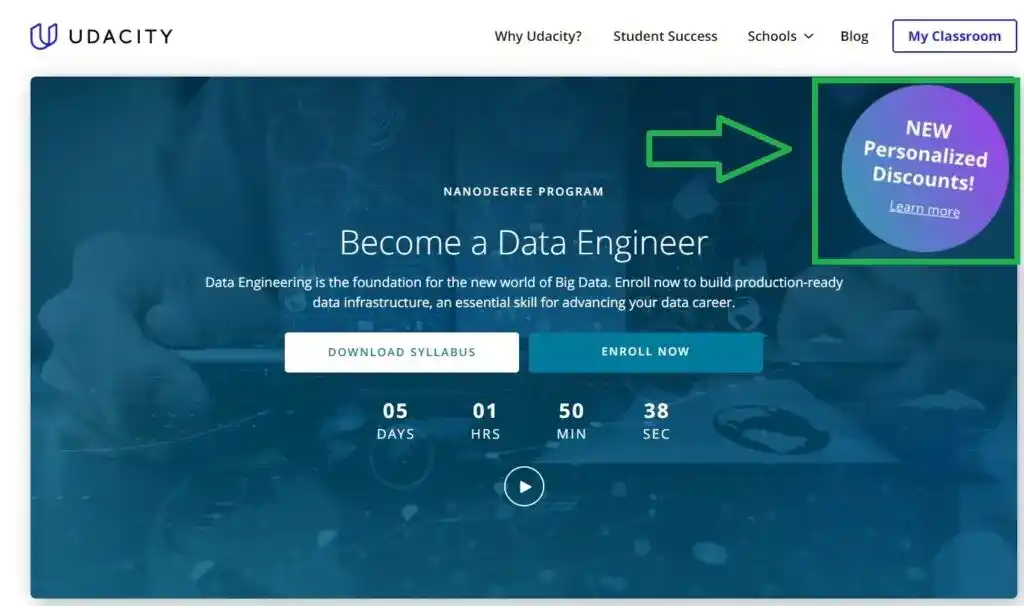
When you click on the “New Personalized Discount”, you will be asked to answer 2 questions.
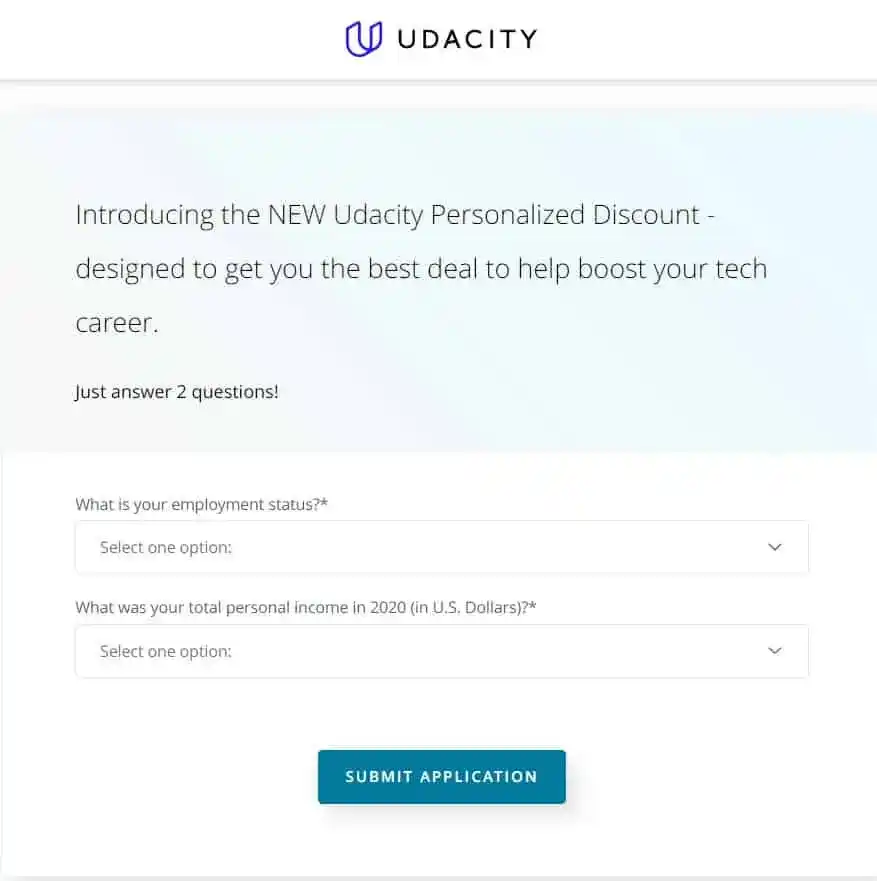
After answering these two questions, press the “Submit Application” button. And then you will get a discount with a unique Coupon Code. Simply copy this code and paste it at the time of payment.

Now, you can save your money in Udacity Data Engineering Nanodegree Program. If you get the Udacity Data Engineering Nanodegree at discount, then I would say it is totally worth it.
Final Thought

Udacity Data Engineering Nanodegree is good for you if you have intermediate-level Python and SQL knowledge and want to advance your skills as a Data Engineer. And if you want hands-on practice and believe in “how” to do things like ETL and Data Warehousing.
Student Reviews
I’ve learned, and applied, skills that I’d always wanted to get to grips with. After hearing so much about Relational and NoSQL databases, it’s satisfying to become confident building them with PostgreSQL and Apache Cassandra in only the first two projects!
Rob R.
My first project was very challenging to me but the reviewers and my mentor helped me constantly in improving my code and documentation and guided me well towards finishing the project. It was a great learning experience and looking forward to the other projects as well.
Nitheesha T.
The program is good, but you need to look at the dataset in the first project. I’m not completely new to ETL, but to have a requirement “Sparkify are interested in the songs their users are listening to”, then a dataset that doesn’t get near that must be confusing for real newbies.
Nicole S.
Now it’s time to wrap up this Udacity Data Engineering Nanodegree Review.
Conclusion
I hope this Udacity Data Engineering Nanodegree Review helped you to decide whether to enroll in Udacity Data Engineering Nanodegree or not?
If you found this Udacity Data Engineering Nanodegree Review helpful, you can share it with others. And if you have any doubts or questions, feel free to ask me in the comment section.
All the Best!
FAQ
Yes, Many Nanodegree graduates have gotten jobs. Udacity has surveyed over 4,200 Udacity students and the survey results showed that nearly 70% of Udacity students surveyed indicated that a Nanodegree program helped them advance their careers. And you can check Top Companies that Hired Udacity Graduates here.
The Dice 2020 Tech Job Report labeled data engineer as the fastest-growing job in technology in 2019, with a 50% year-over-year growth in the number of open positions.
The report also found it takes an average of 46 days to fill data engineering roles and predicted that the time to hire Data Engineers may increase in 2020 “as more companies compete to find the talent they need to handle their sprawling data infrastructure.”
According to Indeed, the average salary of a Data Engineer is $129,001 per year in the United States and a $5,000 cash bonus per year.
Yes, you can mention Udacity projects in your resume. That’s the main objective of Udacity to work on projects so that your portfolio becomes stronger and you can get jobs.
You May Also be Interested In
8 Best Data Engineering Courses Online- Complete List of Resources
Best Course on Statistics for Data Science to Master in Statistics
8 Best Tableau Courses Online- Find the Best One For You!
8 Best Online Courses on Big Data Analytics You Need to Know in 2025
Best SQL Online Course Certificate Programs for Data Science
7 Best SAS Certification Online Courses You Need to Know
Data Analyst Online Certification to Become a Successful Data Analyst
15 Best Books on Data Science Everyone Should Read in 2025
15 Best Online Courses for Data Science for Everyone in 2025
Data Analyst Online Certification to Become a Successful Data Analyst
Thank YOU!
Explore More about Data Science, Visit Here
Though of the Day…
‘ It’s what you learn after you know it all that counts.’
– John Wooden
Written By Aqsa Zafar
Founder of MLTUT, Machine Learning Ph.D. scholar at Dayananda Sagar University. Research on social media depression detection. Create tutorials on ML and data science for diverse applications. Passionate about sharing knowledge through website and social media.

